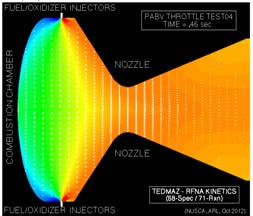
By Tracie Dean, U.S. Army Research Laboratory
ABERDEEN PROVING GROUND, Md. (Aug. 5, 2013) — A team of Army researchers developed a new gel-propellant engine called the vortex engine.
Michael Nusca, Ph.D., Robert Michaels and Nathan Mathis were recently recognized by the Department of the Army with a 2012 Army Research and Development Outstanding Collaboration Award, or RDA, for their work titled, “Use of Computational Fluid Dynamics in the Development and Testing of Controllable Thrust Gel Bipropellant Rocket Engines for Tactical Missiles.”
Nusca, a researcher in Army Research Laboratory, or ARL’s, Propulsion Science Branch at Aberdeen Proving Ground, explained the new technology.
“Gelled, hypergolic propellants are swirled with the combustion chamber to promote mixing and combustion,” Nusca said. “Traditionally, Army missiles used on the battlefield utilize solid propellant in the rocket engine. These engines require an ignition source and once initiated cannot be throttled without special hardware, both of which add weight to the engine. Liquid hypergolic propellants ignite on contact without an igniter and the engine can be throttled by regulating the propellant flow. In addition, if the propellants are gelled, the storage tanks have been shown to be insensitive to attack, unlike liquids that can explode when the container is punctured.”
This new engine was developed with Michaels and Mathis, both researchers at the Aviation Missile Research, Development and Engineering Center, which is one of the U.S. Army Research, Development and Engineering Command’s, or AMRDEC, elements located at Redstone Arsenal, Ala.
“At AMRDEC, the propellants, injection systems and engines were developed and test fired, while at ARL the physics of propellant injection, combustion and engine operation were modeled using supercomputers,” Nusca said. This modeling included both current engine and fuel designs as well as proposals for design alternatives aimed at enhanced performance. The synergism of research between the two labs proved the technology worked according to design.”
“This award recognized the cooperative effort between the ARL-WMRD, or Weapons and Materials Research Directorate, and the AMRDEC-WDI, or Weapons Development and Integration, in maturing a new rocket engine technology for Army tactical missiles.”
Commenting on the impact this body of work could have on the operational Army, Nusca said, “This technology has the potential for game-changing impacts on the future of small, selectable thrust rocket engines for Army tactical missiles, as the main propulsion system, as well as strategic missiles as a course correction system. AMRDEC and the Program Executive Officer for Missiles and Space have direct uses for this technology.”
The primary use and application of this technology has been on the battlefield.
“Eventually the Soldier will have access to a tactical missile on the battlefield that can be used for a variety of missions due to the selectable thrust capability,” Nusca said.
Nusca believes this technology has other applications that will also produce significant results for missile systems.
“The next step for this type of technology would be a full-scale flight test of the vortex engine at AMRDEC for a particular missile system. This test would extend the successful engine test-stand firings and computer modeling and demonstrate increased missile range and thrust modulation in flight,” Nusca said.
The RDA awards recognize outstanding scientific and engineering achievements and technical leadership throughout the Army’s commands, laboratories, and research, development and engineering centers.
Nusca was thrilled to have received the recognition by the Army for the team’s work.
“Receiving this RDA for cooperation makes me feel proud to be a part of ARL and AMRDEC efforts to produce basic and applied research that is increasingly relevant to the Soldier to whom we owe the best battlefield technology that we develop,” Nusca said.
- ARL is part of the U.S. Army Research, Development and Engineering Command, which has the mission to develop technology and engineering solutions for America’s Soldiers.
RDECOM is a major subordinate command of the U.S. Army Materiel Command, or AMC. AMC is the Army’s premier provider of materiel readiness, technology, acquisition support, materiel development, logistics power projection and sustainment, to the total force, across the spectrum of joint military operations. If a Soldier shoots it, drives it, flies it, wears it, eats it or communicates with it, AMC delivers it.







